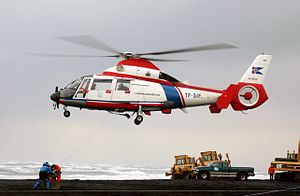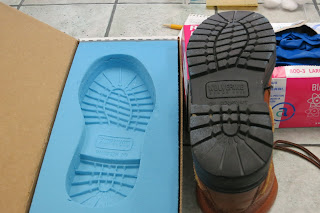_________________________
| (Photo credit: Wikipedia) |
It was a nighttime landing at a church parking lot. The helicopter circled to come in with the wind direction. I was ready for wind - I was not ready for the gale that swallowed me. Debris flew by, and I ended up ducking between cars for safety.
| Helicopter with patient (Photo credit: Wikipedia) |
rescuers work four
days a month: two twenty-four-
hour days and two eight-hour days.
* The teams from V.C.U. work as a
group of three to include:
1. The pilot - who knows nothing
about the patient in order to maintain his
focus on piloting safely.
2. A medevac nurse
* Team members are rotated so that:
1. they are used to working with everyone from
their location
2. to avoid complacence
3. to avoid bad habits.
* Surprisingly, most of their work is not flying crash victims to the hospital.
Most of their work involves moving patients from smaller hospitals, where the
equipment, medication, or expertise is lacking, to a larger
hospital which is better positioned to handle the medical crisis.
* Getting a patient into the right environment within a 1-3 hour window creates a significantly higher
survivability rate.
* The VCU team flies up to Maryland, Washington D.C., down to North Carolina,
and west to Virginia Tech. While many of the large universities have their own flight evac teams
and their own hospitals that they represent, on this level there is a great deal of comradery, reciprocity,
and shared resources. The teams will transport for each other depending on availability and location.
Video Quick Study (6:00) Excellent overview of a simulated rescue moving a patient from a lower level
hospital to a trauma center. In this video:
* The average take off time for this team is 6 minutes
* They like the team to touch the helicopter in 90 seconds
* As they are flying in the hospital is gearing up. They can be in surgery cutting into the patient
within 3 minutes of landing.
Video Quick Study (4:00) Response to a car accident with head trauma.
Video Quick Study (11:00) GRAPHIC IN NATURE - please consider your tolerance. A soldier with a
brain trauma is being treated on the flight. This is NOT A SIMULATION. You may
want to mute the music to focus on the organization of the medical equipment and the
medical interventions that are being performed on the floor of the helicopter.
This job is considered one of the most dangerous jobs in the United States.
One of the bad thing that can happen is called: Flicker Vertigo* Is not caused by inner ear issues like normal vertigo - it is a visual issue
* Causes queasiness and confusion
* Can effect the patient as well as the pilot. This is particularly concerning where a patient
has a history of motion sickness or epilepsy.
* Full face visors work like sunglasses to protect against this.
PDF resource that is much more thorough
Video Quick Study (0:23) experience flicker vertigo
Another big danger happens in landing around power lines.
* Lines are difficult to see especially at night. (Which you can easily see in my video above)
* The helicopters are equipped with hooks that would trap and cut the line to protect the helicopter
and the rescue workers.
Video Quick Study (3:00) Skip right to the 2:10 mark. Helicopters and power lines are a bad combo.
If you are writing a flight evac scene, you will need to make a lot of decision, just like real-life rescuers do.
* Before any information about the patient or the situation is offered, the weather is checked.
* It is important that a safe decision is made based on data alone, without figuring in the heroics of the rescue
team.
* Once the weather is determined to be safe, then other decisions are considered.
| (Photo credit: Wikipedia) |
rescue team does NOT have access to the lower half
of the patient's body.
* A woman in labor is a no-go on the helicopter
Will the patient fit?
* The space is limited.
* These rescue workers have had a patient
with an enormous girth before. They had to lubricate
him in order to squeeze him in to the cramped space - it
makes for an uncomfortable ride, and it ups the danger quotient.
Weight.
* A helicopter can only carry so much weight.
* The flight crews weight is documented and put into a mathematical calculation as is the weight of the
passenger they are going to pick up.
* Jet fuel weighs about 7 lbs per gallon. The pilot calculates for distance. It takes 1.1 gallons of fuel
per minute of flight. They are flying at 120-140 nautical miles per hour. A nautical mile is 20%
longer than a regular mile - so this is equivalent to about 188 mph. The pilot indicated that this was the
speed of a NASCAR driver on a medium track. Of course they are moving in linearly, unlike a car,
so the distance is shorter. (And how much does that fuel at 1 gallon per 1.1 second cost? As of the writing
of this post it was $4.90 per gallon tp $6.50 depending on contracts. YIPES! That's an expensive
rescue!) At any rate, the pilot is calculating whether or not he can hold enough fuel for the distance of the
rescue.
Once the patient is stabilized, packaged, and loaded:
The nurse and flight paramedic have all of the resources of an emergency room to include:
* Respiration apparatus
* Defibrillators
* Medications
* Wound dressing
HELICOPTER SAFETY
Approach
* The helicopter has two engines
* The blades move at 450 mph which about six times per second.
* The blades can flex downward which is a decapitation hazard.
* To approach safely only do so from the front.
* If you are positioned to the rear of the helicopter make a large arc to the front
* Get permission to approach by signaling the pilot either by radio or hand signal of your intention and wait
for a thumbs up.
Heliports
| (Photo credit: Wikipedia) |
* Nurses, technicians, and maintenance workers are
all trained to minimize risk - but we all know in
an emergency sometimes our bodies just act. This
is the wrong place for that to happen.
* Hospitals have a dedicated elevator ONLY for
medevac rescue.








 \
\






